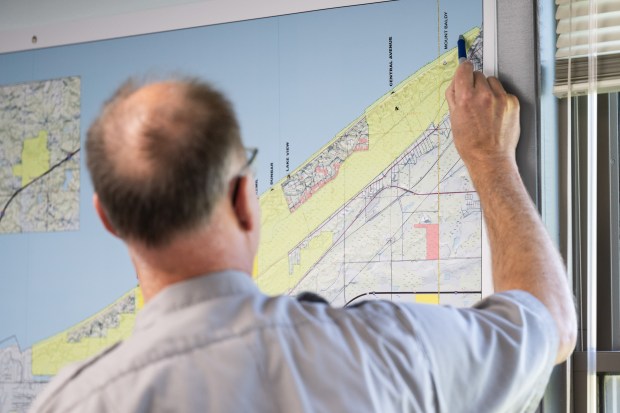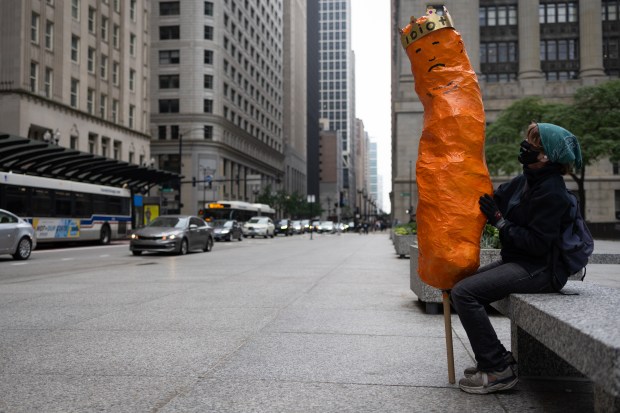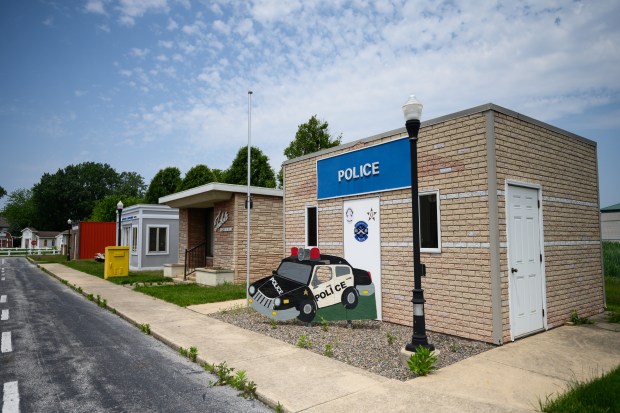PORTER — Indiana Dunes National Park Superintendent Jason Taylor has been here only since June but is already forming ideas on improving the visitor experience.
Taylor’s priorities include “ensuring we have a world class national park visitor center experience,” he said. The park shares the visitor center on Indiana 49 with Indiana Dunes Tourism, Porter County’s convention and visitors bureau.
“We need to put more energy into making sure that the National Park Service is felt and seen and the presence of the arrowhead (NPS logo) is there day in and day out,” Taylor said.
“I’ve been at national parks all over the country. You walk into Denali or Yellowstone and it’s almost not about what you see, it’s about what you feel,” he said. “So you walk in the door and there’s a there’s a particular feeling that you get that I’ve come to expect.
“Whether it’s layout or flow through or services or exhibits or what we hang on the walls, what we see when we walk in the building, the noises that you hear, the sounds that you hear, all of those things come together in my mind to create a national park visitor center experience,” he said.
When Porter County was distributing a portion of its $33 million in American Rescue Plan Act funding, Indiana Dunes Tourism made a pitch for funding, noting that not only were repairs needed there but also improvement to the visitor experience.
Miller Woods
Taylor also wants to promote the Paul Douglas Center for Environmental Education in Gary’s Miller area. “What a fantastic place,” he said.
“The park has invested many hundreds of thousands of dollars in the Douglas Center,” Taylor said, addressing the HVAC system, plumbing, painting, flooring “and just kind of revitalizing the inside of the Douglas Center over the last couple of years.”
The $2.7 million bridge over Lake Street brings people from the parking area and nature play area to the Douglas Center and then provides direct access to Miller Woods. The bridge also now is high enough for Gary’s trucks to pass under, providing city services more easily.

Miller Woods is a particular favorite attraction. “If you haven’t been there in a while, oh my gosh, the work that has been done to restore the black oak savanna. I got here in late May, June. It’s one of the most beautiful places,” Taylor said. “It’s fantastic!”
The Douglas Center has yet to return from pre-COVID-19 attendance. “We’re hoping for a new grand opening and kind of reinvigoration there also of the services we offer,” he said.
Goodfellow Lodge
The former Goodfellow Lodge, adjacent to the Dunes Learning Center, is also a favorite.
“As we talk about to the historic restoration projects going on in the park, things are so expensive I think I’ve lost track of the value of a dollar these days,” Taylor said.
The Goodfellow Lodge was U.S. Steel’s summer camp for workers’ families. “We’re spending $13 million to renovate the Goodfellow Lodge, so for me it’s this underlying philosophy that public facilities should be available to the public. We’re going to spend $13 million to renovate that facility outside and inside — that’s not money to furnish it; we still have to get there.”
“We don’t yet know what the intended long-term use of the facility is other than it will be available to the public on a regular basis. That’s a priority for me,” Taylor said.
“I grew up 3.5 hours north of here, but it’s the same story,” he said. “You have a big industry in a community that’s really heavily influential in the community, has been for a very long time, and the communities both prosper and suffer a bit and have through time and relation to industry, but it was critically important to the communities then and now still today.”
“This place represents the steel industry and the communities at the same time, representing family and community and nature and spending time in nature, so if there’s one place in this entire park that for me most or best signifies the region, it’s someplace like Camp Goodfellow and this rich history of industry with its rich history of family and nature all in one place. Being able to tell that story in this park at that place I’m super excited about that,” Taylor said.
The building looks like an enormous log cabin, but the superstructure is actually steel, he said.
Among the features inside was a bowling alley downstairs, long since ravaged by time and wildlife like the large colony of raccoons that had used the building after humans stopped doing so.
Bailly Homestead
Restoration of the exterior is happening at Bailly Homestead’s main building, the house where Joseph Bailly — the first white settler in that area — raised his family.
The interior will need to be renovated later.
Just what the future use of that building, like the Goodfellow Lodge, will be remains undetermined.
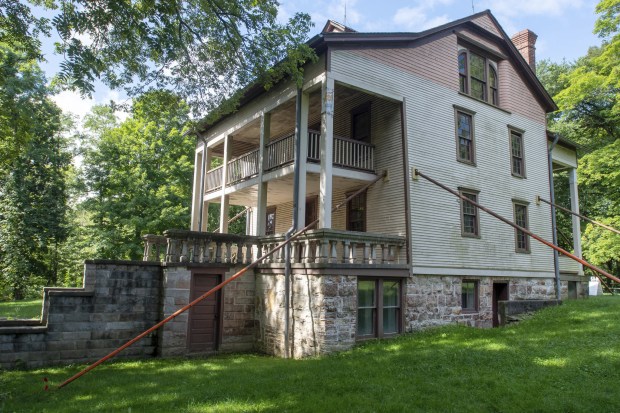
Braces were put in place to shore up the house at the Bailly Homestead at the Indiana Dunes National Park in Porter, Indiana in this 2022 file photo. (Andy Lavalley for the Post-Tribune)
The park put out a request for proposals a few months ago and got only two responses.
In the past, before the national park was created, the Bailly Homestead was used as an inn and as a restaurant, among other uses.
Compliance with the Americans with Disabilities Act would be difficult beyond the first floor of the building. There are steep stairs to reach the second story.
House of Tomorrow
The House of Tomorrow is also getting exterior work. It’s the final home from the 1934 World’s Fair, in the Century of Progress district, and in need of significant work.
The National Park Service has leased the houses to Indiana Landmarks, which sublets the buildings to tenants willing to pay a premium for living there and renovating the interior to National Park Service standards. Tenants also have to agree to let visitors in their homes during an annual open house.
Renovations cost several million dollars, but the tenant gets to live in the home for 50 years on a long-term lease. After the lease expires, the home will be available for park programming or other uses, Taylor said.
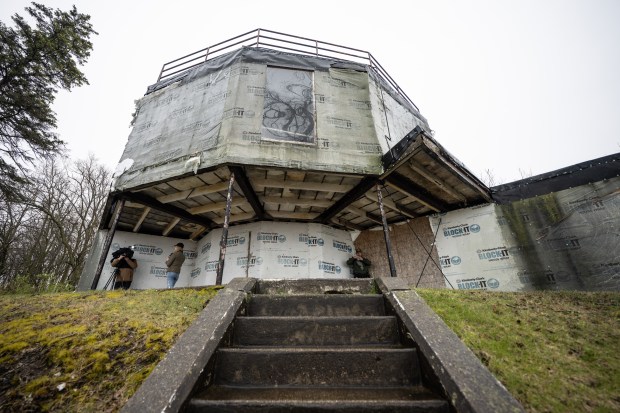
The tenant basically pays $7 million worth of rent up front, plus renovations, he said.
The House of Tomorrow was noteworthy for its passive solar heating and cooling as well as an airplane hangar — think garage — and automatic dishwasher, all of which were innovative at the time.
“I was just over there two days ago, and the sheeting was off and 2-by-4s going up,” Taylor said.
The renovations at the Goodfellow Lodge, Bailly Homestead and House of Tomorrow were funded through the Great American Outdoors Act, he said. The work is expected to be done in September 2025.
Mount Baldy
At Mount Baldy, the National Park Service faces some tough decisions.
Sand blowing over the top of Mount Baldy has already covered a roadway that served as an exit to the parking lot. In another year, a manhole offering access to the sewer will be covered if the dune continues its southward march at its current rate. In 2.5 years, the restroom facility could be compromised.
Leaving the sanitary sewer system to be buried under a sand dune on the march isn’t an option, he said.
There are some signs that the dune’s momentum is slowing, Taylor said. Up top, on a ranger-led march, visitors can see marram grass growing, holding sand in place, he said.
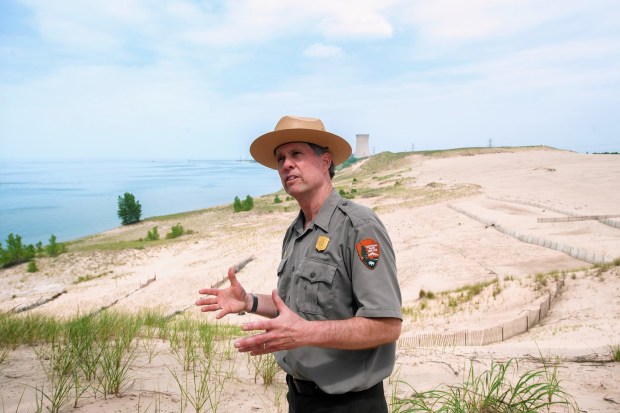
Indiana Dunes National Lakeshore Park Ranger Bruce Rowe talks about methods in which the erosion of Mount Baldy is being fought in this 2022 file photo. (Kyle Telechan / Post-Tribune)
Before the first pier was built at Washington Park in Michigan City in the late 1830s, Mount Baldy was a stable dune like others along the lakeshore. The pier interrupted the natural flow of water and sand along the southern shore of Lake Michigan, putting Mount Baldy in motion.
One option would be to find another way to access Mount Baldy, but Taylor doesn’t want to cut access through undisturbed land.
The U.S. Army Corps of Engineers is experimenting with artificial reefs to see how those affect erosion along the shoreline. Taylor said that could have implications for all along the southern shore of Lake Michigan, depending on how effective it is.
Another option is to remove sand from the south side of Mount Baldy and use it for beach nourishment, essentially putting the sand back where it came from.
“We do have to make a decision, actually, within the next year,” Taylor said.
Doug Ross is a freelance reporter for the Post-Tribune.


